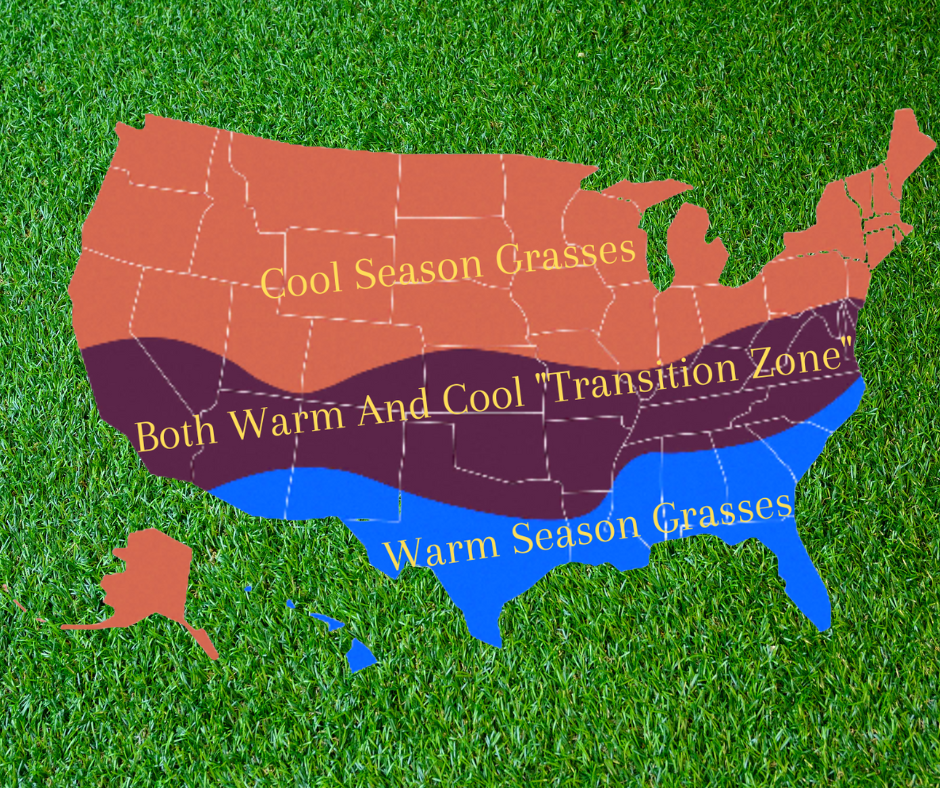Warm And Cool Season Grasses, What are They?

Cool Season Grasses (C3) and Warm Season Grasses (C4) are grasses that have evolved to survive within different temperatures zones. The temperature zones can then be separated into different regions where either C3 or C4 grasses have been manipulated/evolved/designed to survive; in the world today; more effectively within each zone to make beautiful and functional lawns, sports fields, golf course etc.
The northern part of the United States is mostly Cool Season grasses (C3), the southern part mostly Warm Season grasses (C4) and you guessed it, the middle part, the “Transition Zone” is a blend of both where Warm Season grasses do well in the summer months and Cool Season grasses do well in the cooler months but not vice versa.
“Ok, I get what you’re saying Ross! But what is the difference?”

Cool Season grasses close their pores (Stomata) when it gets too warm; roughly 80F and up, Warm Season grass do not. Cool Season grasses do this because they lose too much water when photorespirating during the photosynthesis process (energy making process/food source). They try to conserve water and ultimately this shuts down photosynthesis because there is a buildup of oxygen in the plant that is not getting released, meaning that they are not creating carbohydrates for energy. Consequently, when the stomata close, the plant heats up even more because it has eliminated a cooling method.
If continued hot weather occurs, the C3 grass is forced to use and deplete its carbohydrate storage and is unable to make more until the temperature cools. This results in the decline and eventual death of the grass plant because it doesn’t have any recuperative capacity at that time.
“What’s the difference between C3 and C4 grasses?”
C4 grasses have an evolved anatomy that results in a different adapted photosynthesis process for warmer weather that does not close stomata when things heat up. Resulting in a continued ability to recover from everyday stresses and an undisrupted carbohydrate production system in the heat. This ensures C4 grasses continue to thrive and grow as long as they have enough sunlight each day.
C4 grasses however an inferior photosynthetic ability in suboptimal temperatures; around 50F and below, especially when daylight hours are limited. The colder it gets the less carbohydrates are produced which leads to an inability to develop, recover and repair effectively.
C3 grasses also have a slowed photosynthetic process at low temperatures (40F and below) but not to the same extent as C4 grasses. C4 grasses also have a faster growth rate and organic matter accumulation that C3 grasses because it has a faster photosynthetic process. Ultimately, when this process is slowed down, it has greater impact on the health of the plant.
Common C3 grass species are bluegrass, ryegrass, bentgrass and fescue.
Common C4 grass species are Bermudagrass, Zoysia, Paspalum, St Augustine and Centipede.

- Advantages of C3 grasses are:
- Can stripe better due to thicker wax layer (cuticle).
- Can handle shade.
- Have a general slower growth rate.
- Require less fertilizer.
- Require less water.
- Have deeper rooting.
- Generate less thatch compared to C4 grasses.
- Can be seeded easily
- Disadvantages of C3 grasses are:
- Not great in prolonged heat.
- Wear tolerance and recovery is low.
- High disease proneness.
- Cannot recover from being scalped.

- Advantages of C4 grasses:
- Have an aggressive growth habit.
- Can handle mechanical injury.
- Some species are salt tolerant.
- Has low disease pressure.
- Can be scalped down to remove thatch.
- Can recover from drought.
- Loves heat!
- Disadvantages for C4 grasses are:
- Require more fertilizer.
- Require aggressive thatch removal
- Require 7+ sunlight hours
- Have more insect pressure.
- Require more water.
- Dulls mower blades faster.
- Majority have to be sprigged to be established.
© 2023 LaPageBrands, LLC. All rights reserved.

